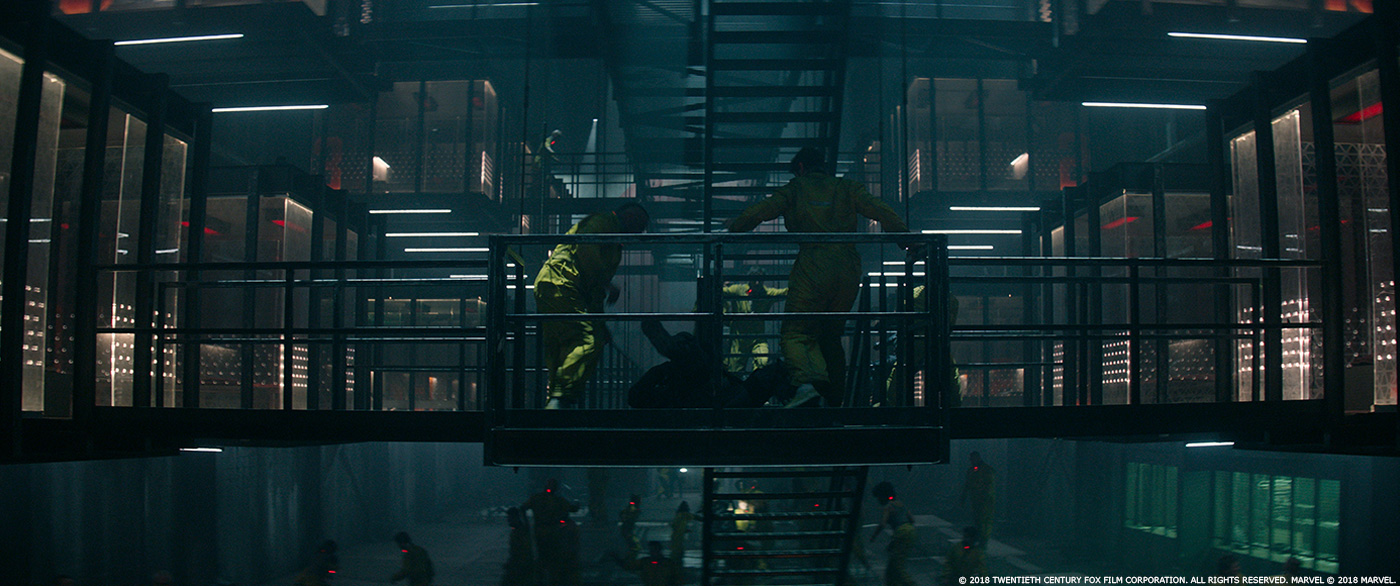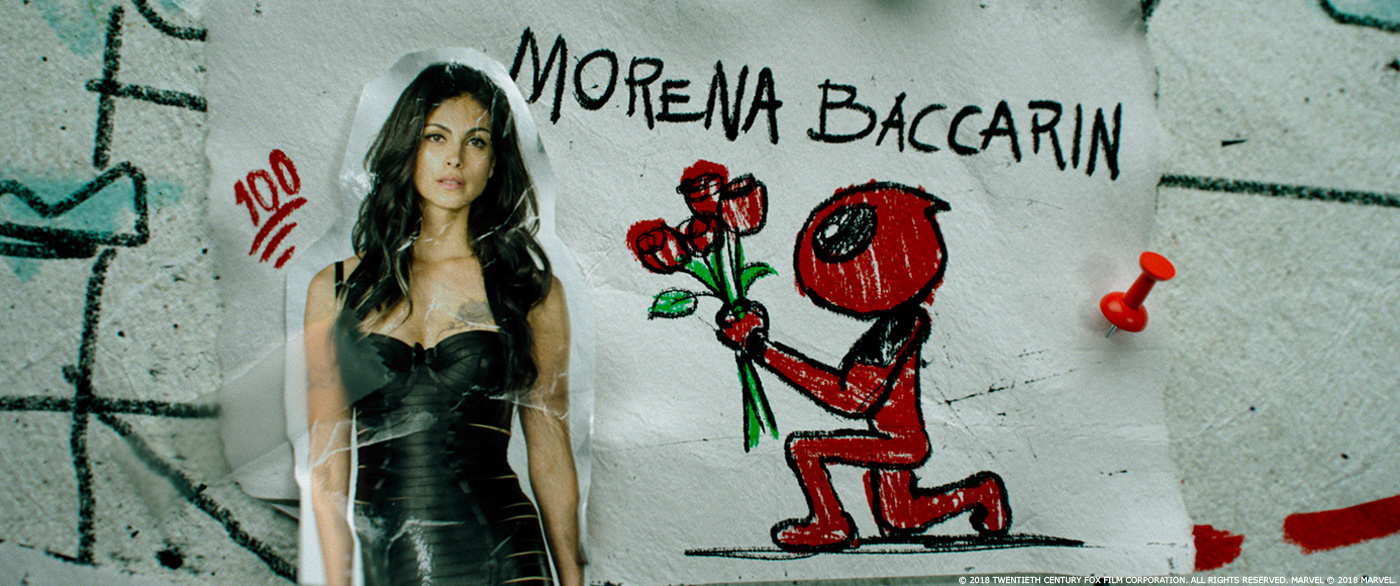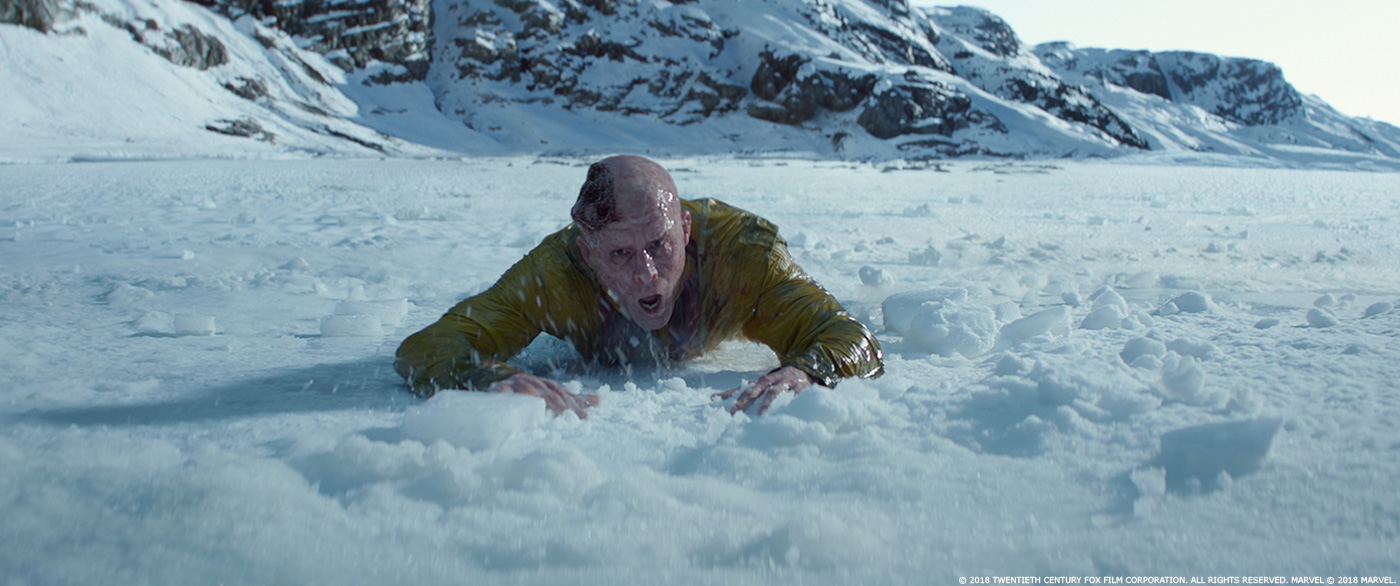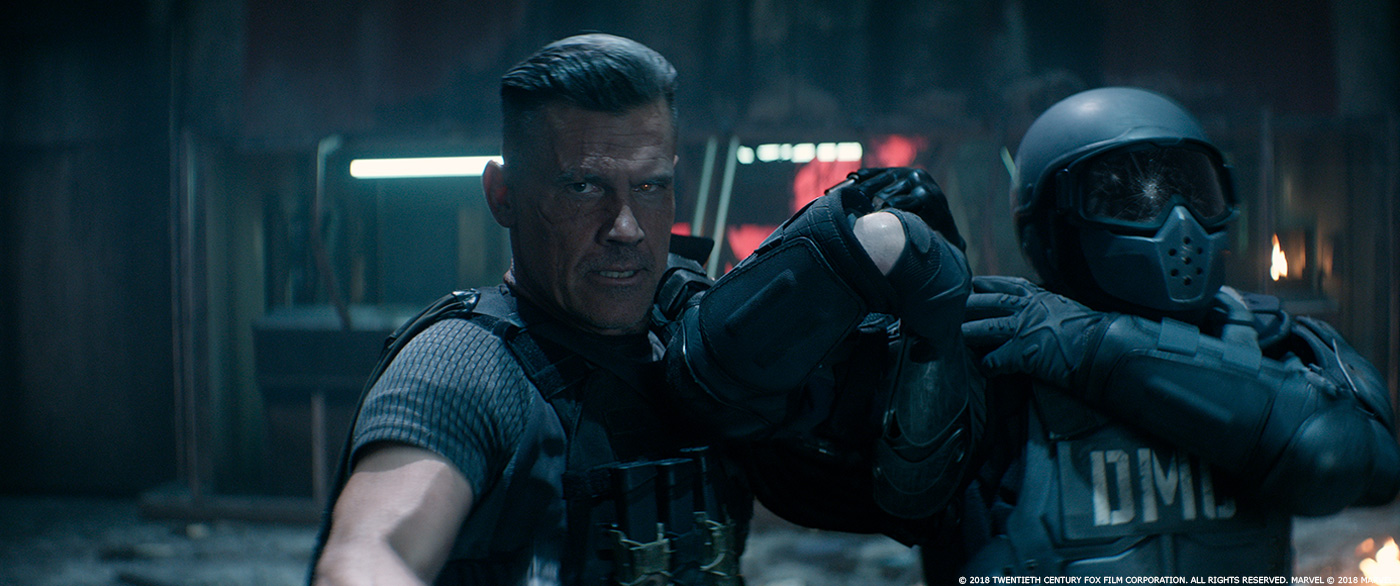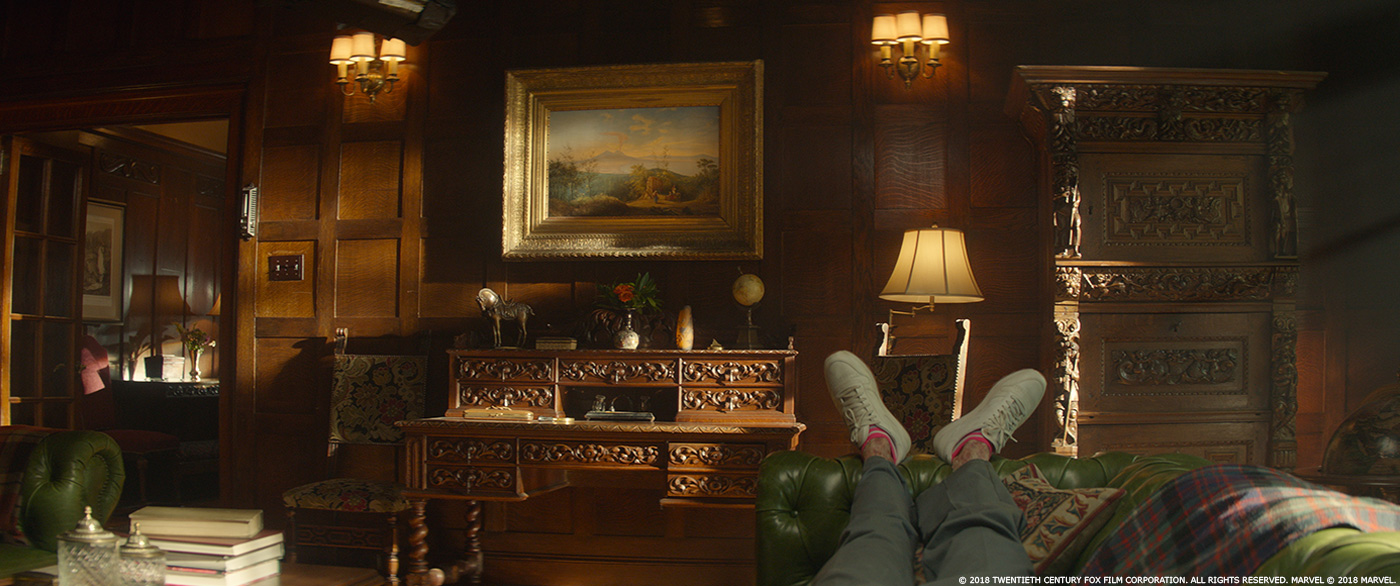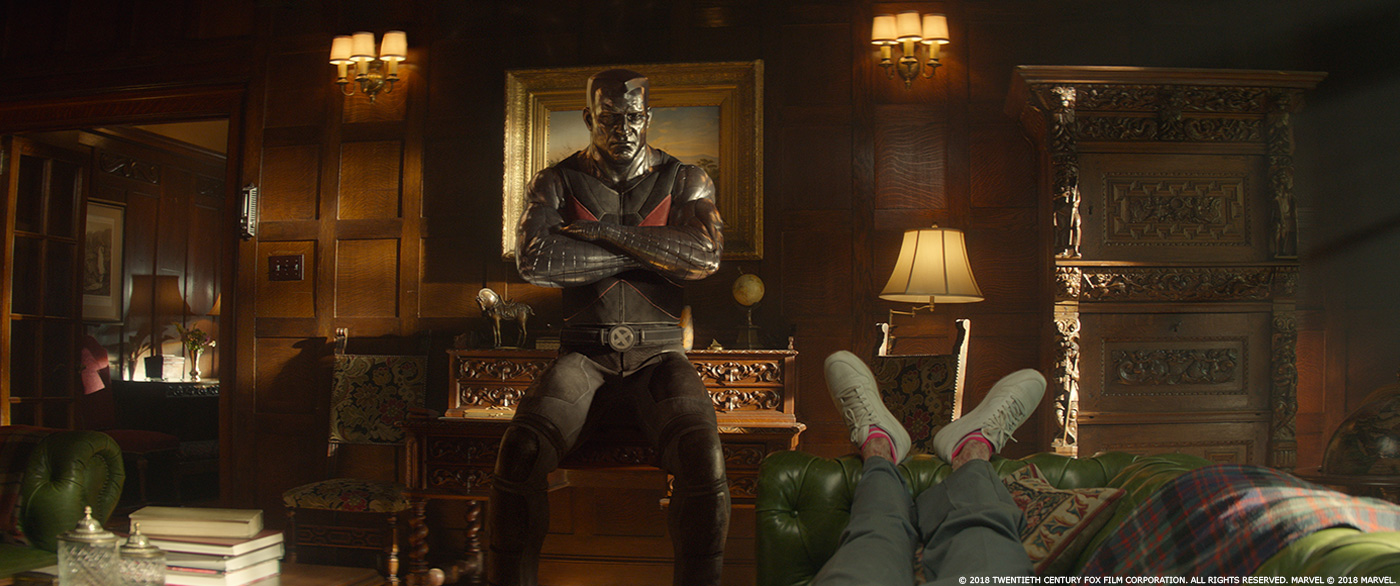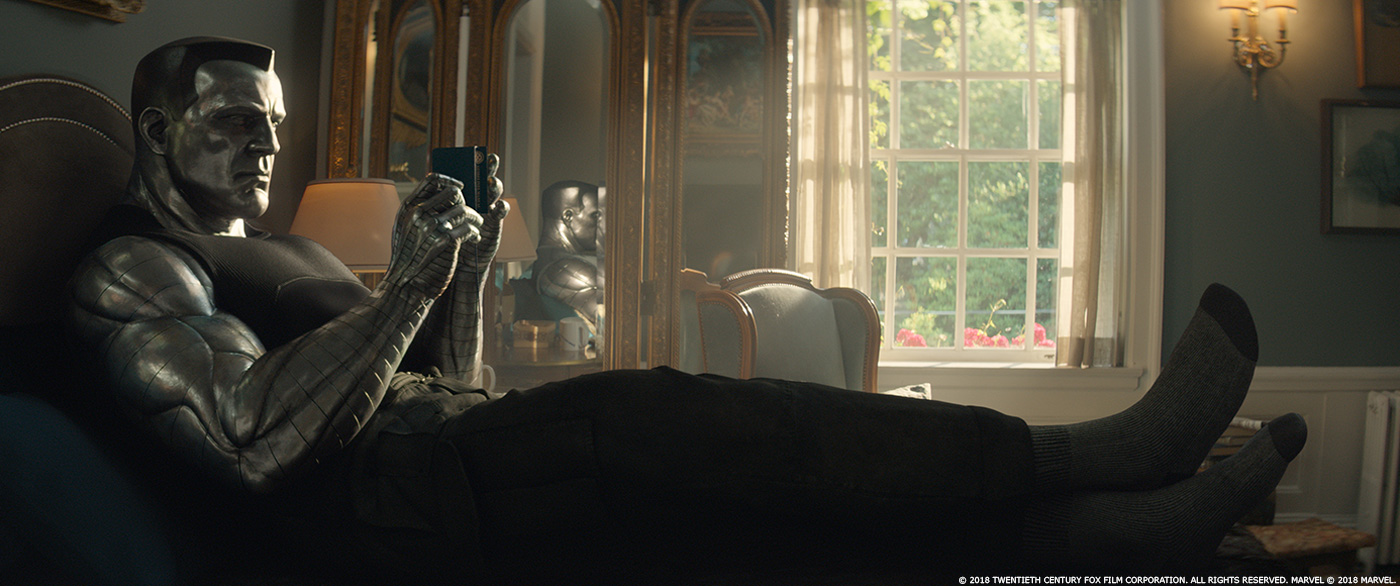Sean Konrad began his career in visual effects in 2000. He worked in several studios like Prime Focus, Zoic Studios and MPC before joining Method Studios in 2016. He worked on films such as TRON: LEGACY, GODZILLA, GUARDIANS OF THE GALAXY and JUSTICE LEAGUE.
John Likens began his career in motion design 10 years ago. He works in many agencies like Perception NYC, The Mill and Blind before joining Method Studios in 2014.
What is your background?
Sean Konrad // I come from a compositing background mostly, but I’ve done work in pipeline and technology project management.
John Likens // In college I studied Graphic Design, and just before I graduated, I taught myself how to animate to pursue my interests in motion and film.
How did you get involved on this show?
Sean Konrad // Dan Glass (studio side VFX Supervisor) actually hired me at Method, so when he got involved in the show, we ended up having a few preliminary discussions to talk about the work he was considering giving to Method.
John Likens // Dan Glass, who had been at Method Studios for many years, needed help to develop some graphic elements that they wanted for the flashback montage showing what Deadpool has been up to. During that time, I decided to visualize a concept for an idea I had for a Bond-esque opening title sequence. After creating about 20 different style frames showing how the sequence could work, I pitched it to David Leitch, the Director, and Dan Glass, they both really responded it. They had a piece of music written for it, which was ultimately recorded by Celine Dion, and we got to work bringing this sequence to life right away.
What was your feeling to be in the Deadpool universe?
Sean Konrad // I was pretty excited to be involved — Colossus and Cable were both characters that I loved when I was younger, and I appreciated a lot about the structure of this movie. It’s a bold move to make the main point of conflict in the film not with a villain character, but surrounding a situation. Deadpool as a character provides a great opportunity to mess with conventions.
John Likens // For me it was pretty surreal. I’ve been a Deadpool fan for a long time. In fact, when I was in school and teaching myself to animate, I once scanned some pages of a Deadpool comic book and tried to bring him to life. I’ve come a long way since those days, and I feel extremely fortunate to have had the chance to work on DEADPOOL 2.
How was the collaboration with director David Leitch and VFX Supervisor Dan Glass?
Sean Konrad // David and Dan were both very in sync with each other, so the direction was always pretty clear, and if we had alternative ideas that made sense for the movie, they were pretty receptive. I found that they were able to make evaluations of rough materials pretty well, so it allowed us the freedom to explore ideas with animation or FX and get meaningful feedback quickly.
John Likens // It was extremely collaborative, and in the best way. They trusted me and my team to come up with and execute our ideas. They also gave us many of their own ideas as well to work into the sequence. There was a lot of back and forth about the jokes, figuring out what was funny, what visuals we should include or not include, if it was working for the storytelling, etc.
What was their expectations and approaches about the visual effects?
Sean Konrad // Dan and Dave wanted to get a lot in camera. In the end, we only had a single all CG shot in the entire film, which was a top view of Deadpool jumping between two buildings in Hong Kong. The last few shows I’ve done have all had at least 15-20% all CG shots, so this was a pretty big paradigm shift.
It’s sometimes easier to work in heavily plate-based shots, because it’s pretty clear when an element isn’t photographic or doesn’t move correctly — however it can also make finishing details that much more time consuming. I had a great compositing sup, Andrew Brooks, so we figured out the best techniques early on. But in general, the direction was get as much in camera as possible and use that as the basis for the VFX.
How did you organize the work with your VFX Producer?
Sean Konrad // Chris Anderson and myself knew pretty early on that there wasn’t going to be a lot of time between the director’s cut and the final delivery date, so we jumped on any targets of opportunity to answer creative and logistical questions at the outset of the show, and tried to get as much face time as possible while the client team was available to us. That made a huge difference near the end of the project.
How did you split the work amongst the Method Studios offices?
Sean Konrad // Vancouver was the primary facility, New York tackled the opening sequence and the final credits, and also helped us out with a few FX gore tasks in the bath house sequence. Pune did a chunk of the plate prep/roto and tracking work, and Los Angeles was involved in conceptual work for the afterlife sequence.
What are the sequences made by Method Studios?
Sean Konrad // We did the “9 to 5” opening mercenary mission sequences where Deadpool travels from Hong Kong around the world tracking down baddies, a couple of Colossus sequences after he’s brought back to the X-Mansion and later in the movie when he’s hiding from Deadpool in his bedroom, the prison break sequence including the aftermath where the guys are tumbling down the mountain, the afterlife, and a few other miscellaneous shots throughout the movie.
Can you explain in detail about the creation of the opening and end titles sequences?
John Likens // For the opening, we did many rounds of design revisions, to figure out which images we should showcase in that title sequence, getting all of the ideas out in the open and seeing which ones would stick. Once we made the final shot selections, I moved into an animatic phase. Creating a greyscale version of the sequence allowed me to quickly block out all the shots, see how the character would move, and how the camera would animate from shot to shot. Once we received approval, I was able to bring in the ultra-talented VFX artists and animators here at Method Studios, to start crafting the final sequence. The opening sequence required help from every department; everyone was able to bring something to the table, it was one of those jobs that everyone was so excited to be a part of it pushed us to do our best work.
About three weeks before the film was due, David asked us to pitch ideas for the main-on-end title sequence. I got to work right away and came up with a few design directions that we could pursue. Everyone really responded to the idea of showcasing crude Deadpool drawings and hand-written credits. There was lots of room there to fit in a ton of extra little jokes, funny drawings, and even work in some Deadpool memes.
I drew about 60 unique drawings for the sequence and about 30 of them ended up in the final edit. It was a blast coming up these drawings, going back and forth with David and Ryan Reynolds about what jokes we should include and what should be written on certain cards.
What kind of references and indications did you received for these titles sequences?
John Likens // Knowing that we wanted to pull off something that was Bond-esque, I studied just about every Bond sequence ever created. Digging through the original works by Maurice Binder and Daniel Kleinman gave me a good foundation of reference to start creating my own compositions.
The opening sequence is taking place in various locations. How did you create these environments?
Sean Konrad // The opening shots were photographed on rooftops in Vancouver — we modified the plates to look like Hong Kong. The subsequent action that takes place in the Triad bar was shot on a blue screen set at Mammoth Studios in Burnaby. We returned to nearby rooftops to shoot panoramas (we weren’t sure what time of night we would settle on so we spend about 4 hours capturing panos), the buildings were then modified with signage so that it felt like a busy Hong Kong street.
Similar approaches were done for the Yakuza bath house scene, the rest of the opening sequence was either done on set or on location.
Deadpool is really gory. How did you enhance the various fight and extreme wounds?
Sean Konrad // We had a lot of dismemberments and decapitations in our sequences. We knew that we wanted to have some flexibility in where the chops were going to happen, so we fit an ecorche to all of the character models that we knew we had to damage, which we would then chop up and add detail to once we had an initial pass of animation done — this gave us a correct anatomy for the muscles/bone structures.
The blood itself was intentionally kept a little cartoonish and light in order to maintain the light feeling of the scenes. We wanted the wounds to be graphic and a little gross, but we didn’t want the majority of the crowd to start feeling nauseous.
One of the bigger/grosser effects that we did was on the head wound that Wade suffers while sliding down the mountain where we exposed some of his brain and skull. We’d built a digidouble for Wade for a few digital takeover shots so this provided a good base to build from.
Although not super gory, we also did a few limb breaks in the prison sequence — the shot where Wade breaks his back on a picnic table got a big reaction from the audience screening I was in, and the later shots where he strangles Cable with his own arm were pretty interesting to do. They used a rubber tube on set to block in the action with Brolin and Reynolds, and then we modified or replaced the plate arm as necessary.
Later in the movie, Cable arrives in a prison. How did you create his eye and arm?
Sean Konrad // The eye and arm were originally created by the team at DNEG. They gave us a basis for the asset, and while we were working through some specific challenges with the movement and the way that the eye optically registered, we ended up sharing examples back and forth until we had a refined product.
Cable has really cool toy such as his gun and shield. Can you explain in detail about the creation of these various FX elements?
Sean Konrad // The gun blast look evolved from references of sonic weapons in other movies as well as cymatics videos that Dan showed us early in the process. DFX Supervisor Sean Schur worked with the FX team to create a physical logic that we applied to the effect; we decided that the sonic weapon would create a concussive force by compressing the air. There would also be a secondary impact driven by the debris in the environment being sucked into a vacuum behind the front wave.
The cymatics ended up being the basis of the surface of the energy wave, but we ended up barely seeing the pattern through the motion blur of the shots that ended up in the movie.
The shield was developed by DNEG, but we gave it a unique energy signature for when it interacted with the sonic weapon; we tried to sell the idea that the shield was diverting energy around Cable, rather than dissipating or reflecting.
Can you explain in detail about the creation of Colossus?
Sean Konrad // Framestore was the primary vendor on the show, so they’re better to talk to about the evolution of the look and the divergence from the first film. However, while we were waiting on a final version of the asset, we started to do a few character studies (supervised by Animation Supervisor Alex Poei) to define the way he moved, especially in more mundane situations (we didn’t have any fight scenes).
We wanted to know how a guy who is over seven feet tall and weighs a ton will move around an environment that isn’t built for him — archways are occasionally too small, chandeliers will be in his path, and he has to be gentle when he transfers his body weight (for instance, when he sits down in the den on the writing table).
Method did create a ‘casual’ clothing look for Deon in the ‘Say Anything’ scene in the bedroom of the X Mansion. The costume department designed the garments, which we fit to Framestore’s model.
Can you tell us more about his rigging and animation?
Sean Konrad // Because we didn’t have very many highly active shots, we used a very simple muscle system and built shapes for key poses so that the rings didn’t stretch or deform too much. Framestore had a lot more active material and, as a result, they would often increase the size of the gaps between each of the rings sets in interesting ways. We didn’t have as many of these more extreme poses, so when we did that kind of thing, it’s kept fairly subtle.
How does the shiny aspect of Colossus affect your work?
Sean Konrad // There were a lot of challenges with the reflective nature of Colossus. Because he’s 95% reflection, the way he looks from scene to scene can change greatly depending on the energy coming from the lights.
We found a lot of the time that when he was reflecting the real-world domes, he ended up looking kind of bland so in some cases we painted details into the HDRIs to get more interesting shaping on his face or arms. We figured this is kind of what a DoP would do if the reflections weren’t looking great in a shot.
Our lighting supervisor, Christian Emond, figured out a way to get caustic reflection lights coming off of the head and key areas of the body, so that he was having an impact on the lighting of the environment.
Can you explain in detail about the face animation of Colossus?
Sean Konrad // Method rebuilt their entire FACS system for this show under the guidance of our facial animation lead Andrew Park (who specializes in facial animation), in collaboration with our rigging lead Ehsan Hassani Moghaddam and modeler Charlie Kim. Originally, we’d planned to do a blend of facial capture with the voice actor, but his physical mannerisms weren’t sufficiently stoic and he was more expressive than the filmmakers wanted from the character. As a result, we grounded a lot of the mannerisms in aspects of his performance, but muted and slowed down a lot of the broad movements. In the end, the facial animation is entirely keyframe animated in our shots.
In general, the scale of Colossus felt a lot more believable if he moved a little bit more slowly than a real human. I believe Framestore went with a number of around 20% slower than the reference they were using; in our sequence, we found it was occasionally even slower.
How did you design and create the Afterlife sequences?
Sean Konrad // The conception to execution of the afterlife is probably one of the more interesting journeys we took on this show. Early on, Dan had shown me some footage that they’d shot in the first weeks of the project with Wade in a dimly lit water tank, either surrounded in complete darkness or in a submerged version of the set. There were a lot of ideas thrown around in the initial conversations, but we vaguely knew that we wanted to mimic the feel of deep water photography where organic shapes exist as silhouettes and where cardinal directions are ambiguous incorporate memories into the environment in some way make it unclear if this is an actual afterlife or if this is just completely in Wade’s head
We initially did a round of concepts with Philippe Gaulier, one of our Art Directors in LA. He did some very striking images that became the basis of some initial postvis that David Leitch whipped up with the editors. We hit a few speed bumps when we got to the idea of how the memories were incorporated into the environment. Initially we wanted to have the shapes that were floating in the environment to resolve to memories of Wade and Vanessa in their apartment, but in general the reaction was that it was too literal. As a result, the memories evolved into a projector carousel effect that Wade moves through in a couple of shots, rather than something that’s sustained.
Because we knew that there was going to be a lot of (necessary) creative churn with this work, we wanted to make the approach highly iteration-able with my comp lead Daniel Bartha. We did most of the work in this sequence in Nuke, using particles, a 2D fluid solver, and the Nuke V-Ray plugin, along with a whole bunch of elements.
When Wade eventually gets through the environment, he finds Vanessa in their old apartment behind an invisible barrier that he can’t get through. These scenes were shot with a pane of glass in the middle of the room so that Ryan had something to make contact with. Whenever he makes contact a burst of energy is visible on the barrier surface. This was achieved in Houdini using particle and flip solvers. We took a lot of inspiration from bioluminescence and tried to get the slightly self-illuminated/refractive look moving through the distorting surface. The surface itself needed to have a viscosity that didn’t look like any kind of natural liquid, so we time warped the simulations until things looked right.
Near the end of the movie, he makes it through the barrier, which also heals all of his cancer. We had a lot of trouble getting the right patterns coming off of Wade; in the end we did an approach where we simplified the geometry that was colliding with the surface, and even created some layers where the liquid was pouring around a static version of Wade.
Which sequence or shot was the most complicated to create and why?
Sean Konrad // We did one shot that was incredibly complex and was ultimately shortened for the movie version. In the opening montage, Deadpool finds himself in a bathhouse in Tokyo facing down with a bunch of near-nude Yakuza. We did a two-minute-long shot with elaborate fight choreography, CG dismemberments and invisible transitions; the shot itself took a team of 15-20 people to complete and was held together by Comp Lead Allan Lee. Its complexity mostly came from the length, but also because managing the re-times in a sensible way was a project unto itself.
Is there something specific that gives you some really short nights?
Sean Konrad // I think the afterlife work was something that kept everyone who was involved with it up at night, in part because it just required a lot of thought. I remember at one point near the end when we were stumbling through the carousel idea, we started watching experimental films late at night to get our heads in the right space.
What is your favorite shot or sequence?
Sean Konrad // The shot of the meth lab boss (played by Thayr Harris) running away from Deadpool in the lab was a lot of fun. The shot was done with a motion control rig, Thayr’s element was shot at 96FPS, where the background was all happening in real time.
The background is absolute mayhem — a gas canister explodes, as does a fire extinguisher (both CG), and a guy is on fire (the narration notes that it isn’t CGI, which is totally true, they decided the night before that it would be a cool element for the shot, and once the choreography was locked we did a single take with him on fire and it worked perfectly). The trick was figuring out how to time everything in Thayr’s element so that he was reacting to the rest of the scene choreography.
We blocked out the hero moments with markers and audio cues, and then to make sure that things were synced, I live comped from the monitor feed on the day. There were a few moments that we had to correct, but in the end, it was a few frames here and there.
Our job after that was to roto Thayr off the CG plate, add some interactive lighting to him from the fire, throw in muzzle flashes, sparks and extra squib hits, as well as a bit of blood from the chainsaw near the end.
What is your best memory on this show?
Sean Konrad // I absolutely loved working on the meth lab shot with the stunt team, and then seeing that shot from start to completion. I’d been involved here and there and got to give some opinions while we were doing some minor setup on a few shots, but because of the complexity of this shot and the logistics involved, I ended up being at the rehearsal and tried to help figure out some of the problems of the shot and threw around ideas with the team. It was also great to see those folks in action. When the choreography was running long, they ended up pivoting and changing a lot of the content of the shot.
John Likens // The first time I edited the opening animatic together with the music, and it locked in perfectly. That’s when I knew we had something special.
How long have you worked on this show?
Sean Konrad // I was brought on board in July 2017, but I was finishing up another project. Fortunately, we were shooting in Vancouver so it was reasonably easy to hop over to a shoot location for key shots or important days. We are still doing some work for the home video release.
John Likens // All in all, we were on board for this film for about 9-10 months.
What’s the VFX shots count?
More than 300.
What was the size of your team?
Sean Konrad // In the end, we had around 100 folks working on the VFX for this project.
John Likens // The team scaled up and down based on the workload of the moment, but about 24 different artists here at Method executed the opening sequence. The end titles, however, were created with a nimble team of just two other artists.
What is your next project?
Sean Konrad // I’m not allowed to say quite yet.
John Likens // I’m working on a new title sequence that should be out on HBO/Cinemax later this year.
What are the four movies that gave you the passion for cinema?
Sean Konrad // I don’t think there’s any specific movie that made me want to be involved in the industry, but movies like HIGH AND LOW, PERSONA, NAUSICAA, and THE HOST are all inspirations for me.
John Likens // TEENAGE MUTANT NINJA TURTLES (1990), SE7EN (1995), THE DARK KNIGHT (2008) and BLACK SWAN (2010).
A big thanks for your time.
// WANT TO KNOW MORE?
Method Studios: Dedicated page about DEADPOOL 2 on Method Studios website.
© Vincent Frei – The Art of VFX – 2018






